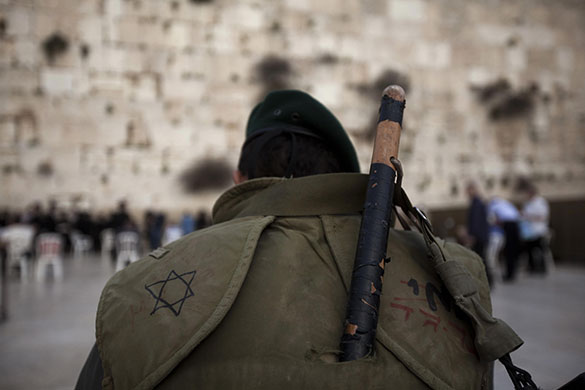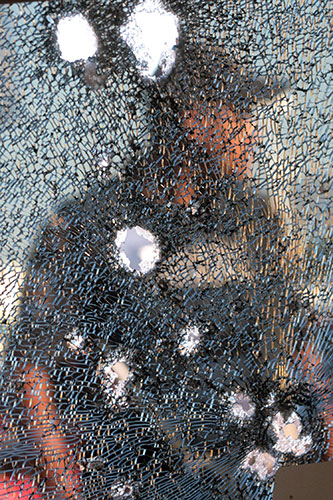Photographs of policeman, often in riot gear, are legion this week. The rioting in Israel/Palestine is one reason for the images, but there have been earthquakes and demonstrations as well as bombings and other flareups of violence around the globe, and in every case the reassertion of law and order is part of the story. Of course, that story is not without irony: you can see people being cordoned, kicked, shot at, detained, arrested, and in some cases even protected by the police, and it often is not at all clear that the cops are on the right side, or that there is a right side. That might provide the most cynical justification for state violence, but the distinction between police and soldiers rests entirely on the assumption that the police are to be defined by just procedures, restraint in use of force, and direct accountability to their fellow citizens. Perhaps the political and moral complications of today’s civil wars are one reason (but not the only reason) why it both is and is not easy to see the police.

This photo of an Israeli border policeman praying before the Wall in Jerusalem is likely to evoke highly polarized reactions. It is part of a familiar archive of religious militants, especially Jewish citizen soldiers (often in ritual garb such as Tefillin), and the reactions are predictable: on the one hand, muscular defense of the sacred; on the other hand, the moral abomination of holy war. This photo would seem to be tilted toward a critical reaction: the rough mantle looks almost medieval, the wooden club is worn from repeated use, the small head seems brutish, and the Wall–his object of devotion–is distant and hazy. It might be titled, “Do Thugs Really Pray?” But what interests me is that his face is not visible.
That lack of accountability, despite the harsh realism of the photo, may be why I think it can be paired with this seemingly very different image:

This photograph–and it is a photograph rather than a cheap painting–captures a policeman in Acapulco, Mexico reflected in glass shattered by gunfire between rival drug gangs. It might seem like something you could buy on the street; or, better, something bought on the street and retouched (defaced) by an artist working with found objects. In any case, and like the photograph above, the scene is one of violence now temporarily inert, and the cop is both there and not there. And in each case a hazy scrim provides some kind of moral buffer: both the religious background of the first image and the aesthetic foreground of the second suggest that we are not supposed to see the police by themselves but rather in a context that justifies their presence.
There are many times when a great deal of violence is prevented simply by seeing the individual cop as the representative of the state. And there are times when it is essential to also see the individual in uniform, and for everyone to see that way. What may be peculiar about the present moment–and we are a long, long way from The Andy Griffith Show–is that we see strong, often paramilitary police forces, and yet we really don’t see the police–not the individual, and not even the institution. Displays of force, it seems, are there to intimidate but not to provide accountability for either those who would break the law or those who would act in its name.
Photographs by Menahem Kahana/AFP-Getty Images and Pedro Pardo/AFP-Getty Images.
Imagery of paramilitary forces ‘passifying’ dissent is often a rhetorical display of strength and terror. Of course, this strength is, on one level, literal (these folks weild guns and tanks and wear armor that can stop rocks, sticks, and bullets). The ease with which they can harm or kill others is bestowed on them by the power of their weaponry. The strength of weaponry (and the people who possess it) and the terror it evokes (to the people who do not possess it or are in the line of fire) is not only a recognition of the power of guns. Additionally, these are very violent props in a larger rhetorical performance. Riot patrols are large in number and size. They are anonymous (i.e. their individuality is concealed under dark, militaristic clothing, metal shields and helmets). Indeed, their bodies conjure up notions of invinicibility and inhumanity; they are just as mechanical as the very tank beside them. In fact, the materiality implied by ‘body’ is completely put under erasure by the rhetorical performances of riot patrol and paramilitary forces. This is only further complimented by the vulnerability, powerlessness, and individuality of the dissenters (e.g. activists, protesters, civilians, etc.). For example:
http://blogs.reuters.com/photo/2008/03/12/this-one-is-worth-a-thousand-words/
But what are some ways in which activists or protesters try to subvert the theatrics of power and terror. On an obvious level, activists try to display there own strength. For example: http://www.belfasttelegraph.co.uk/news/local-national/in-pictures-g20-protests-bring-london-to-standstill-14252925.html. There is also the case of symbolic violence, where activists direct their power and anger at objects instead of the police, as in this example: http://abigailedge.wordpress.com/2009/04/02/anarchy-at-the-g20-smile-for-the-camera/.
But in a number of instances, activists may try to highlight the performative dimension as such, to render excessive and absurd the very rhetorical display implicit in the paramilitary body.
http://www.apollo18.co.uk/index.php?showimage=76
In these instances, the protestors do not fall into the trap of just trying to over-power the paramilitary police forces, an effort that will almost-always result in violence, symbolic or otherwise. But perhaps these images are too absurd to constitute some sort of persuasive effect or potential. Indeed, many audiences would witness the “The Clandestine Insurgent Rebel Clown Army” with disgust and repulsion rather than identification. Still, if there is something to be said for this sort of tactic, it’s that the context that is produced by the absurd performance is one that denies a simple rationale or justification for the presence of paramilitary police violence. In other words, it defies the reasons for the use of paramilitary force to begin with and at least requires audiences to reconsider the reasons for, and extent to which, force is even necessary in the first place.
Bryan: Thanks for the thoughts and links. I almost posted on the captioning I’ve seen lately of photos of cops beating demonstrators. There have been many examples of being told that the police are “detaining” or “restraining” protestors when in fact the photographs show that they are being punched, kicked, thrown to the ground, or otherwise mauled. The text may pretend to being neutral, but it’s not neutral while it once again obscures what is being shown. It becomes too easy to not see the police who are actually there, and that makes it less likely that we’ll see the police who should be there.